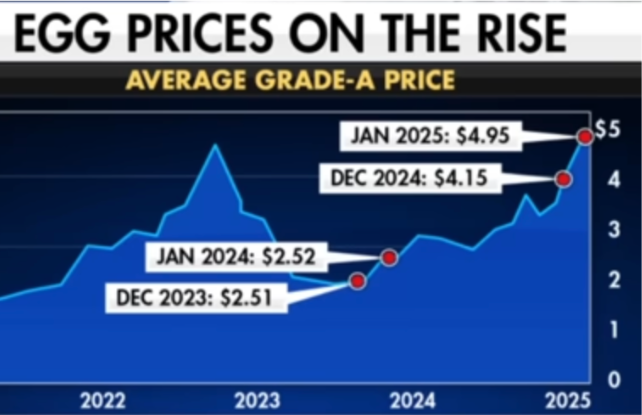Breaking News
Eggflation: Why Egg Prices Remain at Record Highs

Source: YouTube
Shoppers are now using a new term to describe the rising prices of poultry products: eggflation. For months, egg prices continue to rise, which is frustrating consumers and businesses alike. A month into President Donald Trump’s presidency, the national average for a dozen eggs hit $4.95 in January, a staggering 53% increase from the previous year’s prices. While many factors are at play, the primary driver remains the ongoing bird flu outbreak, which has significantly reduced the nation’s egg supply.
The Avian Flu Crisis and Its Impact on Eggflation
The United States Department of Agriculture (USDA) reports that bird flu outbreaks have forced farmers to cull millions of hens, limiting egg production. Over 150 flocks have tested positive for the virus in the past 30 days, and each infected bird must be destroyed to prevent further spread. With fewer hens producing eggs, supply has remained tight, leading to higher costs. The wholesale price for eggs rose by 40 cents in the last month, reaching $7.40 per dozen for distributors. Consumers are now facing price surges in grocery stores as retailers pass these costs along.
Despite efforts to rebuild flocks, recovery is slow. Farmers need time to raise new layers, and as long as bird flu cases persist, it will be difficult to stabilize supply. The USDA warns that there is “little chance for improvement” in egg availability in the near term.
Retailers and Restaurants Struggle to Cope with Eggflation
Grocery chains are adapting to the shortage by placing purchase limits on eggs. Stores like Trader Joe’s and Costco have capped purchases to prevent hoarding and ensure availability for more customers. Some restaurants, such as Waffle House, have even added surcharges to egg-based dishes. These measures reflect the severe impact the supply shortage has had on both businesses and consumers.
Not all retailers are passing on steep price hikes. Trader Joe’s, for example, has managed to keep egg prices relatively low by purchasing directly from suppliers and controlling costs through private-label branding. The chain currently sells eggs at around $3.49 per dozen, significantly lower than the national average.
Eggflation, Consumer Behavior, and the Federal Reserve’s Dilemma
The rising cost of eggs is not just a supply chain issue—it is also shaping consumer perceptions of inflation. As prices for everyday essentials like eggs climb, shoppers may assume inflation remains high across all categories. The University of Michigan’s recent sentiment survey found that consumer inflation expectations rose to 4.3%, the highest since late 2023. If these expectations persist, they could influence economic behaviors, such as increased spending before prices rise further, creating additional inflationary pressures.
This puts the Federal Reserve in a difficult position. The central bank has signaled potential interest rate cuts, but a premature move could risk reigniting inflation, especially if consumers respond to perceived price instability by accelerating their purchases. Economist Torsten Sløk warns that if the Fed acts too soon, it could repeat the inflationary spiral of the 1970s. For now, policymakers are likely to take a wait-and-see approach, focusing on broader inflation trends rather than isolated price spikes like eggflation.
Will Eggflation Ease Eventually?
Experts predict that relief may not come immediately. The USDA projects that egg prices could climb another 20.3% this year if bird flu outbreaks persist. However, once flocks are replenished and supply stabilizes, costs should gradually decline. Some analysts believe prices could start falling in the latter half of 2025, barring any new disruptions.
In the meantime, consumers looking for price stability may need to explore alternative options. Premium egg brands and free-range products have seen fewer price fluctuations, and some retailers continue to offer promotions for loyalty program members.
Down with Eggflation
Eggflation remains a pressing concern for households and businesses, driven by bird flu-related supply issues and broader economic factors. While relief is expected, it may take months before costs return to normal levels. Consumers should brace for continued volatility while policymakers navigate the broader inflation landscape.
How can government tame eggflation in the coming months? Tell us what you think!

1 Comment
Seems like the warehouse birds are still healthy because they’re isolated. All the store brand from the big box stores are still cheap and plentiful…I doubt they’re buying free range. Liberal animal rights activists allowed it to happen getting people riled up. I don’t care if my bird is in a cage as long as it isn’t sick. Bring back the indoor farms.